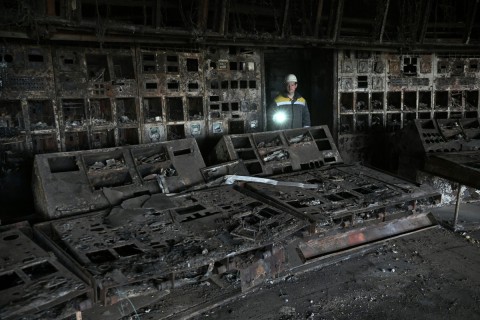

By Anna MALPAS
The clocks had stopped at the exact moment Russian missiles recently ripped into the Ukrainian power plant, where workers were clearing scorched debris under a gaping hole in the roof.
Oleksandr, the 51-year-old production manager at the facility, said it had already been damaged by Russian attacks but noted a worrying difference in damage after the last barrage.
“It’s a lot worse,” he told AFP journalists at the facility, whose location could not be revealed due to fears of fresh attacks.
Russia has stepped up devastating bombardments on Ukrainian power plants in recent weeks, at a perilous moment for Kyiv as it struggles with manpower and ammunition shortages and loses ground on the front.
Of Ukraine’s 15 thermal power plants — like the one where Oleksandr was surveying the damage — at least 12 have been damaged by Russian forces since they invaded more than two years ago.
The barrages have pummelled power distribution cables too and forced Kyiv to introduce biting restrictions on energy consumption and start importing from neighbouring European Union countries.
Oleksandr said the attacks meant pressure was building on nuclear plants, which accounted for around one half of Ukraine’s electricity production before the war.
But Ukraine’s Zaporizhzhia nuclear plant — the largest in Europe — is occupied by Russian forces and no longer producing energy for the grid.
– ‘Very serious consequences’ –
“It’s the thermal and hydroelectric power plants that are being knocked out,” Oleskandr said.
“Nuclear power plants may not be able to cope with that load. The consequences will be very serious,” he added.
The systematic strikes are not new.
They resemble a similar Russian campaign that disrupted heating and electricity to millions of Ukrainians for long periods in the first winter of the war.
But Ukraine’s energy minister German Galushchenko has said the current bout is causing greater lasting damage because Russia is using more sophisticated weapons.
Some officials in Kyiv have urged the country to completely decentralise its electricity grid to reduce its dependence on larger power stations vulnerable to attack.
The latest strike on the coal-fired plant run by energy provider DTEK hit during the night.
It damaged facilities that had been repaired after earlier strikes, Oleksandr said.
In the wake of the attack, workers in hard helmets were repairing offices, covering windows and replacing lights.
A poster on the wall proclaimed: “Believe in the energy workers!”
Oleksandr picked from the ground a metal missile fragment still bearing a serial number.
“They are all over the plant,” he said.
The attack blew off parts of the roof and ripped through walls, severing vital communications systems and sparking several blazes.
Most staff went directly to bomb shelters. Critical workers remained on duty in the safest areas of the plant, barricaded behind sandbags.
– ‘We need air defences’ –
“It’s a great miracle and thank God that no one died or was wounded,” Oleksandr said.
President Volodymyr Zelensky has said Ukraine needs at least seven more Patriot air defence systems to protect its cities and key infrastructure.
He conceded last week that Russia had been able to destroy a key power plant near Kyiv region because the air defences ran out of missiles.
“First and foremost we need air defences,” Oleksandr said.
“There is a feeling of frustration, of course. Everyone who works here understands there is a possibility of a similar attack happening again”.
Yuriy, shift foreman for the turbine hall, had already experienced one missile attack at work before the latest strike.
The 47-year-old standing in his control room with burnt-out instruments recalled how he led his staff to safety after the missile attack began.
They did a roll call and walked in line, with those at the front and back holding torches to make sure no-one got left behind.
“I led people to the bomb shelter, even though on the way there were several explosions,” Yuriy said.
“We didn’t know where the next missiles would hit.”
The workers knew from social media that the missiles were in their region and their plant could be the target.
“How can you not be scared when you know it’s flying directly at you?” Yuriy said.
“You can’t put on a brave face. Everyone’s afraid.”
As AFP left the plant, a siren sounded again and workers piled out to shelters.
